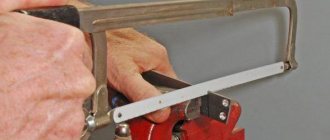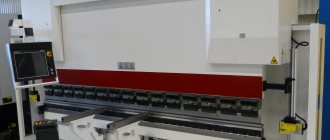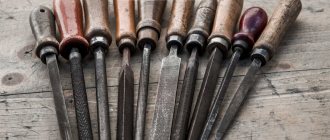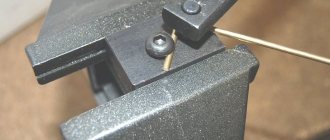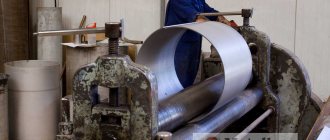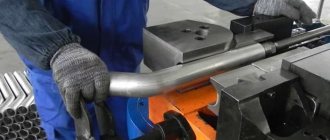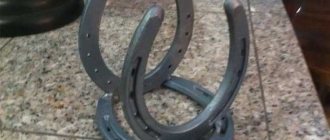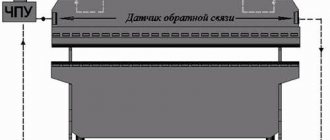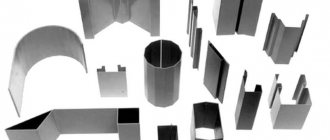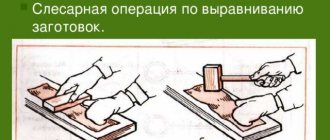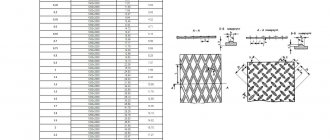The bending process is a metalworking operation by which a metal workpiece, when deformed, takes on the required spatial shape. In the practice of metalworking, a mechanic often has to bend workpieces made of sheet, strip and round material at an angle, with a certain radius, and bend curves of various shapes (squares, hinges, staples, etc.). To perform this work, you must first determine the length of the unfolded workpiece.
When the thickness of the workpiece exceeds 4 mm, hot bending is used.
During the bending process, metal is subjected to simultaneous tensile and compressive forces. On the outside of the part, at the bending point, the metal fibers stretch and their length increases; on the inside, on the contrary, the fibers are compressed and their length is shortened. And only the neutral layer, or, as is commonly called, the neutral line, at the moment of bending, is believed to experience neither compression nor stretching, and therefore the length of the neutral line after bending the part does not change.
When bending metal, you have to overcome the elastic forces of the metal workpiece.
Elasticity is the property of a metal workpiece, due to which the part restores its original shape and size after removing the load. At normal temperatures, limited by the rate and duration of deformation, the part can be considered with sufficient accuracy
elastic until the stresses and deformations arising in it do not exceed a certain value of the elastic limit. Therefore, a part bent to a certain angle after removing the stress tends, like a spring, to straighten out, i.e. The bend angle always increases slightly, and the part straightens a little. Therefore, when manufacturing flexible parts, the springing properties of the metal should be taken into account.
Plasticity is the ability of a material to retain, in whole or in part, the deformation resulting from the action of applied forces even after the action of these forces ceases. Depending on the ratio of the values of residual and elastic deformations obtained before the onset of failure, the material can be considered ductile or brittle. However, ductility and brittleness cannot be attributed only to the properties of the material. The same material, depending on the nature of the stress state, temperature and rate of deformation, can appear as ductile or brittle.
The following stages of plastic deformation are distinguished:
- a) onset of yielding—plastic deformations of the same order as elastic ones;
- b) plastic state at small deformations - plastic deformations are large compared to elastic ones, but small compared to the initial changes in the size or shape of the part;
- c) plastic state under large deformations (technological plastic deformations) - the dimensions or shapes of the part change significantly.
Bending is accompanied by elastic and plastic deformations, which causes distortion of the original cross-sectional shape of the workpiece, and a decrease in its area (shrinkage) in the bending zone (Fig. 1).
Rice. 1. Distortion of the shape of the workpiece during bending: a - round section; b - rectangular section; c - tightening
In addition, folds may form along the internal contour and cracks along the external contour. The stresses of the outer fibers at a relatively small r in these fibers approach the tensile strength, as a result of which the material fails (cracks form). The smaller the radius of curvature and the larger the bend angle, the more likely these defects are. To prevent the appearance of defects, it is necessary to maintain a minimum bending radius.
The minimum bending radius is approximately determined by the formula: r=S·k, where r is the bending radius, k is a coefficient depending on the material and rolling direction, S is the thickness of the material. When bending across the fibers for copper, zinc, brass and aluminum k=0.25–0.3, for soft steel - k=0.5 and for medium-hard steel - k=0.8. When bending along the fibers for copper, zinc, brass and aluminum k = 0.4–0.45, for soft steel - k = 1.2 and for medium hard steel - k = 1.5. By cleaning the edges before bending, k can be reduced by 1.5, and sometimes by 2 times.
The length of the workpiece L during bending is determined by the sum of the lengths of the straight sections and the lengths of the neutral axes of the curved sections, for example, L= l1+ l2+ l (Fig. 2).
where φ is the arc angle f in degrees (φ=180° – β); x is the distance from the inner plane to the neutral axis in mm.
Rice. 2. Diagram of the components of the length of the bent strip
At relatively small r, the stretching of the material in the outer fibers approaches the tensile strength, causing the material to fail (cracks form).
How to bend sheet metal correctly?
Bending sheet metal allows you to obtain a product of the desired shape with relatively little effort. Because welding requires more effort, both physical and financial. A sheet of metal can be bent manually or using automation, but the general principles of operation remain the same. It is the features of this process that will be discussed.
Metal bending is carried out using various methods. Welding is often used, but temperature exposure can change the shape and properties of the finished product. This reduces performance properties and manufacturing accuracy.
Since when bending metal, the outer layers of the metal stretch, and the inner ones begin to compress, it is necessary to bend part of the rolled metal relative to another by a given angle. The angle can be found using calculations.
The product is deformed to those values that are within the specified limits. They depend on the following parameters:
- Thickness of the metal sheet;
- How much is the bending angle?
- How durable is the material;
- Speed and time of the procedure.
The permissible deformation indicator will depend on them. The next step is to select the type of bending.
Types of bending of metal products
Metal bending is done manually and using automatic devices. In the first case, the process will be quite labor-intensive, requiring the use of pliers and a hammer, as a result of which this procedure will take a lot of time.
It will be much easier and better to mechanize the process with the help of machines and corresponding devices. The cylinder shape is given to the product by special rollers. With their help, chimneys, gutters, and pipe products are created.
The development of machine tool production has made it possible to achieve bending of material for the manufacture of the most complex products. And the quick replacement of the working tool allows you to reconfigure the machine device as efficiently and quickly as possible.
For the modern metal bending process, there are many options for the latest devices. In production, presses are usually used , which can be divided into the following types:
- Rotary, bending metal by moving between special rollers. Suitable for the production of large-sized products in small batches.
- Rotary presses bend the plates using bending beams and two plates. The stationary plate is located at the bottom, and at the top there is a rotating plate. The optimal option for processing sheet metal products with a simple relief and small dimensions.
- Standard pneumatic or hydraulic presses are used for mass or small-scale products made of stainless steel or other metal. Bending is done between the punch and the die. Due to this, even thicker products can be processed. It should be noted that hydraulic presses are used more often than pneumatic ones due to their simpler operation and cost.
Of all the types of equipment described above, the most modern is rotary. It operates automatically, and the worker does not need to calculate the optimal force value in advance.
Rotary presses are also considered automated. Here one sheet is sent to the device, which must be positioned as required by the task. Most often used in small enterprises where they work with metal parts.
Handmade
This work is usually done with hand scissors . Marks are placed in the right places along which manual bending of the metal will be carried out. The sheet is securely fixed in a vice. The first fold is made with a massive hammer. The product is moved to a new bend location, clamped with a block of wood, and bent in the desired direction.
Upon completion of the work, you must ensure that the product meets the established standards. The check is carried out using a square and, if necessary, defects are eliminated.
Sometimes you need to make a machine at home . This will make bending metal easier and increase productivity. Here you will need a corner, a metal beam, hinges with bolts, clamps, handles, a table and a welding machine. The procedure is as follows:
- The base is made of metal; an I-beam profile is suitable.
- The corner is attached to the top of the beam using bolts.
- Three hinges are welded under the corner using a welding machine.
- We bend the aluminum sheet by turning the corner.
- Two clamps ensure tight pressing of the metal.
- The corner does not have to be removed; you can raise it. Place the product between the profile and the corner. Then a metal sheet is aligned along the edge.
Check the bolts to ensure they are secure. Turn the crossbars and bend them so as to form the desired angle. This will avoid wasting time on angle calculations.
Whatever the devices, the main principles remain the same . By following them, you can obtain products that meet the standards and wishes of the customer.
How to bend sheet metal at home - About metal
In the process of building a house or cottage, there is often a need to equip drains, sewers, and metal frames.
When manufacturing such products, it is necessary to give the flat workpiece the necessary spatial shape. Advice from experienced craftsmen on how to bend a sheet of metal at home will allow you to produce good quality structures that will last a long time.
Bending technology - basic information
Metal bending is performed without welding seams, which avoids corrosion in the future and produces a product of increased strength. Deformation does not require significant effort and is usually performed in a cold state.
The exception is hard materials such as duralumin or carbon steels. Sheet metal bending technology is developed according to the assigned tasks in such options as:
- radius,
- multi-angle,
- single-angle,
- U-shaped.
A special case is flexion with stretching. This technology is used in the manufacture of parts with large bending radii and small diameters. When making parts with your own hands, the process is combined with operations such as cutting or punching.
Soft types of metals and alloys, such as brass, copper, and aluminum, are well suited for home processing. The production of products by bending is carried out on rolling or rolling machines, or manually.
The last procedure is quite labor-intensive. Bending is done using pliers and a rubber hammer. If the sheet is thin, use a mallet.
How to bend at right angles
To bend a bracket from a metal sheet, you will need a set of tools and accessories, consisting of:
- vice,
- hammer,
- power saws,
- bar,
- frames
The length of the strip is made according to the scheme, with the calculation that there should be a margin of 0.5 mm for each bend, plus another millimeter for folds on both sides. The workpiece is placed in a vice with squares. Clamping it along the fold line, process it with a hammer.
After this, the future bracket is unfolded in a vice, clamped with a frame and a block, and the other side is formed. The workpiece is pulled out, the required length of the sides is measured, making bends along the bottom.
Use a triangle to check the correctness of the angle, correcting inaccuracies with a hammer. When performing both operations, the workpiece is pressed with a block and a frame. The finished staple is filed to the desired size.
:
How to make a sheet bending machine yourself
To give the metal the desired configuration, tinsmiths use a sheet bending machine. But what should a master do if he doesn’t have special equipment at hand?
In fact, the question of how to bend sheet metal at home is easily resolved. It is enough to use your own ingenuity and basic equipment to make a simple machine.
To make a bender for a metal profile, you will need:
- I-beam 80 mm,
- fasteners (bolts),
- loops,
- corner 80 mm,
- clamps,
- a pair of handles.
You will also need a welding machine and a stable table on which the finished machine is mounted.
The basis of the device is an I-beam, to which a corner is screwed with two bolts, holding the workpiece during the bending process. Three door hinges are attached under it by welding. Their second part is welded directly to the corner.
In order for the machine to easily turn while bending sheet metal, handles are attached to it on both sides. The finished machine is secured to the table with clamps. Before laying the workpiece, the corner is unscrewed or lifted. The sheet is pressed, aligned along the edge and folded, turning the machine by the handles. The homemade device is only suitable for processing workpieces of small thickness.
:
Bending a metal sheet with a hammer
In order to bend a sheet up to 1.2 mm thick at a right angle, use the simplest tools - pliers (clamps) and a rubber hammer.
The processing is carried out on a flat wooden block. The fold line is drawn using a pencil and ruler. Then the sheet is clamped with pliers so that their ends fall exactly on the marking line.
The edge is gradually bent upward, moving along the fold. Once the angle approaches 90 degrees, the sheet is placed on the block and finally leveled using a hammer.
Narrow parts, such as tin edges, are made in this way.
Tip: Use a rubber or wooden hammer to prevent dents from forming on the metal. If bending is performed with a conventional tool, you need to take a textolite plate as a gasket.
It is convenient to bend sheets up to 2 mm thick on a desktop. The metal is positioned so that the marking line falls on the edge. A steel corner is placed under the material being processed.
The sheet is clamped in a vice using two wooden blocks.
Bending is done using a hammer, tapping the metal from one end to the other. At the same time, the edge of the sheet is directed downward so that it ultimately lies completely on the corner fixed along the edge of the table.
This method can be used to make products of any width, including boxes or barbecues.
:
Making pipes without using a machine
Home craftsmen have invented a lot of ways to bend a metal sheet into a pipe without using a machine.
We propose to consider the simplest option using a blank of suitable size. It is made from an old pipe of suitable diameter.
A sheet of metal is laid out on the floor and a piece of the required length is cut from it. To determine the required size, the required pipe diameter is multiplied by 3.14 and added 30 mm for the seam.
A pair of tubes are welded to the blank on both sides, perpendicular to one another. The crowbar should be freely inserted into their holes.
Master's recommendation: by bending a metal sheet using a blank, it is convenient to make pipes no more than a meter in length.
To use the device, the effort of three people is required. The blank is placed on the edge of the sheet. One person stands on top, two others screw the metal onto the blank, turning the crowbar 90 degrees.
The entire length of the sheet is rolled in this way, the remaining edge is hammered. The seam is secured by welding.
:
It must be taken into account that the bend radius of sheet metal depends on its thickness and manufacturing method. Hot rolled steel is more suitable for pipes; profile products are made from cold rolled steel. ( 15,00
How to bend a sheet of metal evenly
Many people ask the question: how to bend a sheet of metal evenly? And it is not surprising, because when carrying out construction work it may be necessary to perform a similar procedure.
Small diameter pipes are bent using a vice. Very often during construction processes there is a need to bend pipes of quite large diameter. For such work, special machines are needed that bend metal sheets and pipes. The bendable component is not deformed.
How to bend a sheet of metal evenly? Stages:
| General technology, principles and features of bending metal sheets. |
| What metal can be bent? The best materials for processing and shaping are brass, copper and aluminum. |
| Bending tools. Before starting work, you should prepare a diagram of the future product and calculate the required angle. After this, you need to acquire tools and materials. |
| Handmade production of a machine for bending sheet metal. Materials and action plan. |
Tip: when bending parts, its thickness, ductility are taken into account and the radius of curvature is determined.
Metal bending technology
Bending sheet metal involves performing certain actions that cause the material to take the desired shape. The process of bending metal is performed without the help of welding or other connections that reduce the durability and strength of the material.
When folded, the outer layers of the product are stretched, and the inner layers are compressed. The technology is to bend one part relative to the other at the required angle.
During bending, the metal sheet undergoes deformation. Its value depends on the thickness of the product, ductility, bending angle and bending speed.
The process itself is performed on equipment, due to which no damage is caused.
If a part is bent incorrectly, various defects may occur on its surface, as a result of which the metal receives various damage along the bending line, which can lead to its breakage.
How to bend metal with your own hands: making brackets
In order to make a bracket with your own hands, you will need:
- a metal sheet;
- hammer;
- bar;
- vice;
- frame;
- electric saw designed for working with metal.
Hot bending of metal sheets.
- First of all, using the diagram, the length of the strip that the workpiece will have is calculated, then it is necessary to calculate the bending of the sheet. When performing the calculation, you should remember that for each bend you need to leave a margin, the thickness of which is 0.5, and the bends of the ends are 1 mm.
- According to the diagram, you should cut out the workpiece, then mark on it the areas for future bending. In order to make a bend, squares and a vice are used.
- The workpiece should be fixed in a vice to approximately the level of the bend. Using a hammer, you can begin making the first bend.
- Next, having rearranged the prepared element, clamp it in a vice and make the next bend.
- Your next action will be to determine the marks for the length of the legs of the future bracket. In order to bend the bracket with the frame, a vice is also used. To do this, you need to bend two of its legs at once.
If you need to clarify the bend, you can use a triangle. In case of incorrect bending, errors can be corrected by using a hammer and a frame block. Having achieved the bend you need, saw off the excess material to get the desired dimensions.
Bending and bending of sheet metal using various methods and devices
Bending sheet metal allows you to obtain a product of the desired shape with relatively little effort. Because welding requires more effort, both physical and financial. A sheet of metal can be bent manually or using automation, but the general principles of operation remain the same. It is the features of this process that will be discussed.
Metal bending is carried out using various methods. Welding is often used, but temperature exposure can change the shape and properties of the finished product. This reduces performance properties and manufacturing accuracy.
Since when bending metal, the outer layers of the metal stretch, and the inner ones begin to compress, it is necessary to bend part of the rolled metal relative to another by a given angle. The angle can be found using calculations.
The product is deformed to those values that are within the specified limits. They depend on the following parameters:
- Thickness of the metal sheet;
- How much is the bending angle?
- How durable is the material;
- Speed and time of the procedure.
The permissible deformation indicator will depend on them. The next step is to select the type of bending.
Calculation of the minimum radius when bending sheet metal
The diameter of the circle of the neutral layer (D0), which is located in the center of a metal sheet of length L and thickness S if it is bent into a drum, is calculated using the following formula:
If the wall thickness of the metal drum is S, then the internal diameter of the product (D) is calculated as follows:
The formula for calculating the outer diameter (D1) is as follows:
Thus, the difference in circumference can be calculated using the formula:
Therefore, the ratio 2πS/πD should be no more than 0.05.
Based on the fact that 2πS/πD ≤ 0.05, it turns out that D ≥ 2S/0.05 = 40S, i.e., to maintain the strength properties of the sheet, the minimum internal diameter of its bending must be 40 times greater than its thickness, and the radius must be 20 times. For example, a cylinder with a minimum internal diameter of 40 mm can be made from a 10 mm thick plate.
Bending and bending of sheet metal using various methods and devices – Machine
March 23, 2021 Bending sheet steel: features of the technological process and advantages of this method of metal processing
Issues discussed in the material:
- What are the advantages of this type of metal processing such as bending?
- What are the methods of bending metal?
- What equipment exists for bending sheet steel?
- What is the sequence of operations when bending sheet steel to order
Steel products are used in all spheres of human life, from industry and construction to everyday life.
In order for a steel sheet to turn, for example, into a finished part, it is processed in a special way.
At first glance, cutting, drilling, grinding and other types of processing seem to be simple mechanical actions. However, in reality they are complex technological processes.
Making a metal object requires special equipment and certain skills. To create a high-quality product, it is necessary to strictly adhere to technology. In particular, bending sheet steel requires special skill and precision.
What is metal bending and what are its advantages?
Flexible sheet steel is a type of processing in which the product is given the desired shape. The result is achieved due to the fact that the top layer of material is stretched and the inner layer is compressed.
There are different ways in which you can bend a metal sheet and change its appearance. The technology makes it possible to obtain a high-quality and durable item of the required shape in a short time. There are two types of technological process in which bending is done:
- Bending sheet steel by hand.
- Mechanical restoration.
In the first case, various plumbing tools are used (hammer, vice, pliers, etc.), in the second, industrial equipment is used.
Manual bending of sheet metal can be performed when its width is less than 0.6 mm. Otherwise, special machines will be required: press brake, rollers, roller bending machine.
Metal is modified not only by bending, but also by other methods - twisting, welding.
Bending is often compared to the latter, since one product can be made in two ways: bending steel at the desired angle or connecting individual parts together using welding equipment.
However, if you do bending, the process will be faster and easier. This is precisely the main advantage of the first technology over the second.
Other arguments in favor of using bending to process sheet steel:
- Using this method, a higher quality, stronger and more durable product is obtained. The areas of metal in the places of bending remain sealed, so the object will be more resistant to mechanical stress.
- The cost of work is lower than when welding.
- Bending is performed in a short period of time.
- If the material is bent by pressing, the risk of damage is eliminated. The technology allows you to obtain the desired shape without compromising quality. The high technical characteristics of the product, in particular, strength, are maintained.
- Bending of sheet steel is used to eliminate any changes in the physical or chemical properties of the alloy, since no significant interference with the composition occurs.
- Using technology, it is possible to produce smooth, seamless, neat parts.
The listed advantages confirm that in order to obtain a high-quality and durable metal workpiece, it is best to bend sheet steel.
Metal bending methods
Classification of types of metal bending:
- According to the type of final profile.
The product can have one angle (L), two (P) or several (if the metal is ductile). In the latter case, multi-angle bending is done without heating the material.It is possible to bend sheet steel along a radius, in which the material is bent onto the workpiece. Hinges, galvanized clamps, etc. are made in a similar way.
- According to the method of deformation (the nature of the force).
Bending can be done freely - the profile is located between two supporting structures, and a force is applied to the central point, as a result of which the material bends.It is possible to bend sheet metal with a calibrating blow. In this case, a spring-loaded support is placed under the workpiece, which moves downward along with the steel sheet.
It happens that the latter method is simplified - at the end of the working stroke of the bending machine, the product is hard stamped.
- By the number of transitions.
The frequency of transitions is influenced by such a property of the metal as plasticity. A metal product without heating can bend up to an angle of 120° (without cracking).If more intensive shaping is expected, then bending is performed with two or three transitions.
If the sheet material has low ductility, then the areas between the transitions are subjected to heat treatment (annealing).
- According to the method of bending.
The process can be performed using equipment that uses reciprocating or rotating movements.In the first option, a hydraulic horizontal bending machine (forging bulldozer) is used if the pressure occurs horizontally, or a mechanical sheet bending machine if it is vertical.
The second method is when sheet steel is bent on rotary machines, where deformation occurs between rotating rolls.
Metal bending is done in a cold state, since no special effort is required for shaping. The exception is alloys that require heat treatment. With heating, sheet steel 12–16 mm thick with a large percentage of carbon, durmalumin, titanium, etc. is bent.
Often, such bending is combined with other types of mechanical processing: cutting, cutting, punching. For the manufacture of complex volumetric products, stamping is performed. A rarer case of metal bending is stretching to produce a narrow, elongated piece with a large diameter.
How does the process of bending sheet steel work?
The technology for forming parts made of sheet steel is that an angle is formed between two sections of the sheet (the degree is strictly specified), for the calculation of which special automated programs are used.
It is important to understand that when bent, the material is deformed to a certain limit, which is individual for each metal or alloy. It is important that the process of manufacturing the workpiece complies with the requirements of GOST for bending sheet steel.
The degree of deformation is influenced by the following parameters:
- Metal thickness
- Bend angle.
- Plasticity and fragility of the material. Technological features of the process.
In order to bend sheet steel without defects, industrial sheet bending machines are used. It is necessary to strictly observe the features of the technology in order for the finished products to be of high quality. Any deviations can lead to the formation of defects, which will affect the quality and strength of the finished metal structure.
Industrial equipment allows you to bend steel sheets of any thickness. In order for the deformation to be plastic, it is only sufficient to correctly calculate the stress created by the equipment.
Sheet steel bending equipment
Today there are various bending machines. The simplest of them are suitable for the manufacture of corners, frame profiles, etc. More complicated ones, used on an industrial scale, are divided into several types:
- A rotary sheet bending machine is a machine in which several rollers rotate, resulting in a rounded shape to the workpiece. In this kind of bending, the metal is placed between the rolls, then moves between them, acquiring the necessary bend. Rotation can be done either manually or hydraulically.
- Sheet bending with rotating beams - the machine consists of a pressing beam and two plates, fixed and rotating. The equipment is suitable for the production of small and simple sheet steel workpieces.
- Pneumatic and hydraulic presses (the second option is more common). They are used in small-scale production when bending stainless steel sheets or other alloys. The part to be bent is placed between the die and the punch. The device is suitable for shaping materials even with large thicknesses.
The most modern equipment is considered to be a rotary machine, on which bending is performed automatically. Thanks to this feature, there is no need to calculate the applied force.
Sheet benders with rotary beams are also automated: the worker only needs to correctly position the sheet on the equipment. Such machines are often used in small manufacturing plants.
Features of bending stainless steel sheets
Stainless steel gets its name due to its resistance to corrosion. This property is ensured by a combination of several elements that are alloying, that is, improving the quality of the base material.
https://www.youtube.com/watch?v=IINnhfZmDHku0026t=4s
In addition to resistance to destruction from rust, impurities add other qualities to the alloy: strength, ductility, etc. There are several types of stainless steel.
Therefore, before bending, you need to know the composition of the alloy.
Before bending the sheet, it is cut - laser, water-abrasive cutting, etc. are used. Using cutting, a flat roll of the future product is created.
For shaping, the sheet is bent to specified parameters. Processing of stainless steel sheets follows the same principle as in the case of other alloys.
As already mentioned, bending is carried out on special automated or mechanized sheet bending machines - machines, presses, etc. Usually the metal is bent in a cold state.
However, if there is a risk that the workpiece will be damaged, then sheet steel is bent with preheating.
In recent years, thanks to the automation of the steel bending process, the company has received the following advantages:
- The volume of manufactured products is increasing.
- Production costs are reduced.
- The quality of finished products increases.
- The number of defective parts is reduced.
To produce a product, it is enough to set up a special computer program, and it will autonomously perform all stages of production with virtually no participation from working personnel.
Sequence of operations when bending sheet steel to order
Bending of sheet steel begins with the development of a technological process, which involves several stages:
- Product design analysis.
- Calculation of effort and process work.
- Selection of standard size of production equipment.
- Preparation of a drawing of the initial workpiece.
- Calculation of deformation transitions.
- Design of technological equipment project.
Before bending, the sheet material is examined to ensure that its capabilities meet the specified requirements. This stage allows you to determine that the metal is suitable for stamping according to the parameters specified in the drawing of the finished part. The following properties are studied:
- Plasticity, that is, the ability of a material to deform under given conditions without destruction. If the metal or alloy has low plasticity, several transitions and heat treatment (annealing) are performed.
- Possibility of bending to the desired angle or radius without the formation of cracks in places of deformation.
- The risk of distortion of the workpiece when bending a product with a complex contour if the impact occurs with high pressure.
If, based on the results of the analysis, it turns out that the metal does not meet the requirements, then one of the following decisions is made:
- A more ductile metal or alloy is selected.
- Before bending, the material is subjected to heat treatment.
- The workpiece is heated to the required temperature.
The technological process of shaping requires some preliminary calculations, in particular, indicators such as bending angle, bending radius, and springing angle.
The bending radius of sheet material is calculated based on how ductile the metal is, what is the ratio of size and deformation speed. The lower the minimum radius, the smaller the initial sheet thickness.
Reducing the thickness is called thinning, the coefficient of which shows how much less the thickness of the workpiece will become. If during calculations it turns out that the indicator is higher than critical, then a sheet product with a greater thickness is used.
The minimum radius depends on such properties of steel as ductility, sheet thickness, and the arrangement of fibers in the alloy.
If you bend metal that has a small bending radius, then deformation of the top layer of rolled metal is possible, as a result of which the quality of the finished product will suffer.
For this reason, the minimum radii should be calculated based on the greatest deformations of the extreme parts of the workpiece, based on the relative narrowing of the material that is being modified.
The bending springback is calculated based on the actual springback angles. When bending steel, it is necessary to take into account the forces that are applied to deform the workpiece.
Strength indicators depend on how ductile the metal is and the intensity of its hardening during bending. As soon as rolling is completed, the material acquires the property of anisotropy, that is, its physical properties change depending on the direction of rolling.
Simply put, if you bend the profile along the fibers, the likelihood of cracks forming in places of deformation is reduced.
In order for the accuracy of calculations of force indicators to be high, it is necessary to take into account exactly how the profile will be deformed. There are two options:
- With a bending element, that is, the sheet is placed between the clamps and bent.
- With force - at the final stage of the technological process, the product rests on the working surface of the matrix.
The first technology is used to produce parts with less energy consumption, the second is used to produce parts with complex contours.
Bending of sheet steel is carried out to form almost any alloy, regardless of whether alloying impurities are present in them or not. This is the main advantage of the technology over other metal processing methods. The only exceptions are materials with increased fragility and a tendency to deform.
Defects and difficulties when bending metal parts
Bending of parts made of metals with low ductility (for example, those containing more than 0.5% carbon) is complicated by a phenomenon such as springing, when the finished part differs in configuration from the drawings. This phenomenon is the main problem in the process of metal processing by bending.
The essence of springing is that the part is subject to elastic consequences after the end of the working load. As a result, a significant distortion of the shape of the workpiece is possible; in some cases, a spring angle reaching 12–150° is possible, which leads to difficulties in connecting adjacent parts to each other.
To eliminate or reduce this phenomenon, techniques such as:
- Compensation of the spring angle by certain changes in the parameters of the working part of the punch and matrix.
This technique is suitable if there is accurate information regarding the grade of the metal/alloy or its strength characteristics, in particular, the limit of its tensile strength is known. When performing important work, it may be necessary to conduct a technological bending test. For example, with a spring angle of 95°, the working edge of the punch must be increased by a similar angle. - Changing the working profile of the matrix. In this case, throughout the entire length of the deformation zone, the workpiece is in constant contact with the working tool. For this purpose, technological undercuts or notches are made in the matrix, if possible.
- Increasing the plasticity of metal. Softness is increased by pre-annealing the part. Billets made of high-carbon steels are annealed at temperatures from +570 °C to +6,000 °C, and from low-carbon steels - from +180 °C to +2,000 °C.
- Bending hot workpieces, since in this case the ductility of the metal increases. But in this case, it is necessary to additionally clean the surfaces of the parts. In addition, after each pass of the punch it is necessary to clean off scale from the working surface of the matrix.
How to bend sheet metal at home
Bending sheet metal allows you to obtain a product of the desired shape with relatively little effort. Because welding requires more effort, both physical and financial. A sheet of metal can be bent manually or using automation, but the general principles of operation remain the same. It is the features of this process that will be discussed.
Metal bending is carried out using various methods. Welding is often used, but temperature exposure can change the shape and properties of the finished product. This reduces performance properties and manufacturing accuracy.
Since when bending metal, the outer layers of the metal stretch, and the inner ones begin to compress, it is necessary to bend part of the rolled metal relative to another by a given angle. The angle can be found using calculations.
The product is deformed to those values that are within the specified limits. They depend on the following parameters:
- Thickness of the metal sheet;
- How much is the bending angle?
- How durable is the material;
- Speed and time of the procedure.
The permissible deformation indicator will depend on them. The next step is to select the type of bending.
Types of equipment
For the modern metal bending process, there are many options for the latest devices. In production, presses are usually used , which can be divided into the following types:
- Rotary, bending metal by moving between special rollers. Suitable for the production of large-sized products in small batches.
- Rotary presses bend the plates using bending beams and two plates. The stationary plate is located at the bottom, and at the top there is a rotating plate. The optimal option for processing sheet metal products with a simple relief and small dimensions.
- Standard pneumatic or hydraulic presses are used for mass or small-scale products made of stainless steel or other metal. Bending is done between the punch and the die. Due to this, even thicker products can be processed. It should be noted that hydraulic presses are used more often than pneumatic ones due to their simpler operation and cost.
Of all the types of equipment described above, the most modern is rotary. It operates automatically, and the worker does not need to calculate the optimal force value in advance.
Rotary presses are also considered automated. Here one sheet is sent to the device, which must be positioned as required by the task. Most often used in small enterprises where they work with metal parts.
Self-production of the machine
Sometimes you need to make a machine at home . This will make bending metal easier and increase productivity. Here you will need a corner, a metal beam, hinges with bolts, clamps, handles, a table and a welding machine. The procedure is as follows:
- The base is made of metal; an I-beam profile is suitable.
- The corner is attached to the top of the beam using bolts.
- Three hinges are welded under the corner using a welding machine.
- We bend the aluminum sheet by turning the corner.
- Two clamps ensure tight pressing of the metal.
- The corner does not have to be removed; you can raise it. Place the product between the profile and the corner. Then a metal sheet is aligned along the edge.
Check the bolts to ensure they are secure. Turn the crossbars and bend them so as to form the desired angle. This will avoid wasting time on angle calculations.
Whatever the devices, the main principles remain the same . By following them, you can obtain products that meet the standards and wishes of the customer.
Equipment Maintenance and Safety
When working with industrial equipment, you must follow safety precautions:
- Before work, employees are given instructions.
- In mechanized machines, electronic control is used to start the working mechanisms. This reduces the risk of injury while working.
It is important to periodically lubricate the moving elements with machine oil to increase the service life of the sheet bender.
Machines for bending metal are used both in enterprises and in private workshops. When choosing equipment, you need to take into account the size and thickness of the workpieces being processed. The type, size and characteristics of the machine depend on this.
